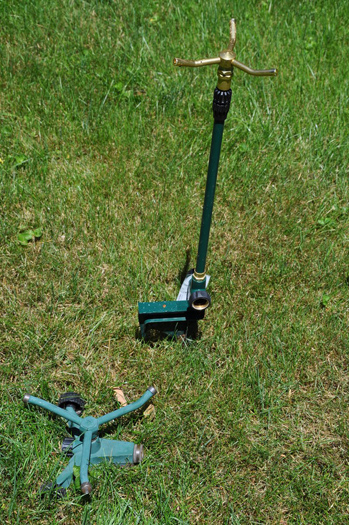

Last week we discussed when and how much to water the lawn. This week, as promised, it’s time to talk about the delivery system.
When shopping for your perfect sprinkler, there are a number of factors to consider, but the primary question is going to be how much of an area do you need to water and how often will you be watering it?
If you have a very sandy lot and only want to keep the barest of ground covered, then you probably don’t want to spend a fortune. On the other hand, you may have several thousand square feet of magnificent lawn that is your pride and joy and spending a few dollars won’t be a problem.
Other things to consider: What kind of a watering pattern do you need? Can most of your watering needs fit into a rectangular or box-like pattern or will a circular pattern better address your needs? And do you need to water a large area or several small areas?
As a primer, there are five basic types of inexpensive (under $50) sprinklers.
Impact sprinklers generally move in circles, though many are adjustable to cover only parts of circles. Oscillators establish a fan-like pattern that moves back and forth, right to left. Stationary or fixed sprinklers generally have a spike- or sled-type of base and either no moving parts or just a couple of parts that spin, causing a particular watering pattern to occur.
Soaker types of sprinklers are used in spots where only a very narrow swath is watered or where the ground is to be wet without wetting foliage (this is ideal for roses). And finally, there are the walkers, which may incorporate an impact-type device on wheels, so that over a period of many hours the device may cover tens of thousands of square feet.
If you are watering a circular area, you may want to consider the impact type of sprinkler.
The impact heads are available from many garden centers and they are rated by the diameter of a circle that they’ll cover and the gallons per hour/minute output. Some are adjustable to cover all or parts of a circle and they may have a spring adjustment to shorten the circle’s diameter. Inexpensive plastic types are available, but for a long service life, try to get the brass (or other alloy) kind.
A sled base will be more expensive, but spike bases that are stuck into the ground tend to loosen and cause wobbling as the ground softens up during watering. This type of sprinkler can also be mounted on a pipe or tripod, putting it above the foliage layer in the garden making it very effective in borders, beds and vegetable gardens. Impact sprinklers are ineffective on windy days or in very windy locations.
Oscillators are rated by the square foot pattern that the water covers and are available in sizes that accommodate from under 2,500 square feet to nearly 20,000. This type of device is best used for rectangular or square areas and is somewhat more wind resistant than impact types.
Again, go for the most expensive and well-built model you can afford, as the mechanical parts will work flawlessly for years so long as you keep sand and dirt particles out of the water. And when the more expensive types do get hung up, they usually need only a quick cleaning out with the self-contained cleaning tool.
Sand will spell doom and result in the need for constant cleaning, so the use of a screen washer connection (available at any garden center or hardware store) is important. One drawback is the proprietary hose connection that some have, so be sure yours has a standard hose connection or well-made adapter.
The stationary or fixed type of sprinklers are generally cheap and cover only small areas, but they are perfectly appropriate for areas of only a couple of hundred square feet. Don’t expect them to last more than a year or two (unless they are the metal type). But then, for a few bucks, what does?
Trickle, soaker and perforated watering devices kind of fit in one category, though each has a rather specific use. Perforated watering hoses come in lengths of 25 to 100 feet and are used to water long narrow beds or stretches of lawn. Care must be taken to control the water pressure, as running a short length at full pressure may cause the perforations to enlarge. Reduce the pressure to a trickle and turn the hose upside-down and you have a soaker that can be used in vegetable beds or rose beds to water without getting any foliage wet.
Soaker hoses are also good for rose bed and vegetable garden jobs as the watering pattern is very narrow (maybe a foot wide), but will soak very deep. Remember that it’s important to reduce the pressure on this type of device and let it run for a long time to allow full soil penetration.
Walking sprinklers were the rage in the 1950s and 60s but in-ground sprinkler systems did them in. They are still available though, but they are not very efficient, ecological or easy.
A walker usually consists of a water screw that is driven by water pressure, which in turn turns a set of wheels. Atop the device is a rotating, adjustable arm with holes at each end that emit water. Spray patterns are changed by adjusting the arms and the track that the walker travels is controlled by either a cable that is stretched in front of the sprinkler or by the hose that it will follow.
For just under $700 you can get a walker that will cover several acres in a day and will pull hundreds of feet of hose behind it. But for most homes, a walker that will pull 150 to 200 feet of hose will be adequate and will only set you back just over a hundred bucks.
Again, this is not the sprinkler of choice as great amounts of water are used and not efficiently. And then there’s always the walker that runs off its track and gets lost.
Remember that sand is a sprinkler killer. If you use well water or if you live near the beach, always install a screen-type washer at the female hose coupling on the sprinkler.
When shopping for a sprinkler, consider cost, versatility, watering patterns provided, volume of water output, ease of operation and ease of repair.
My favorite sprinkler? The old-fashioned Rain Bird impact sprinkler made of brass. These can be set for just about any part of a circular pattern and you can adjust the spray pattern with a turn screw that permits a fine spray to a long stream. They can also be easily adapted to pipe risers (plastic or metal) and with a little bit of maintenance, will last for years.
The 25-PJDA-C is a classic and costs under $20. A larger model that shoots out up to 50 feet runs around $40, while the largest goes for over $200, fires up to 65 feet out and can handle over 16 gallons of water a minute, which is overkill unless you have a golf course or an estate.
Keep growing.
 More Posts from Andrew Messinger
More Posts from Andrew Messinger